Apistogrammas, also known as apistos or dwarf cichlids, enchant aquarists with their vibrant colors and curious personalities.
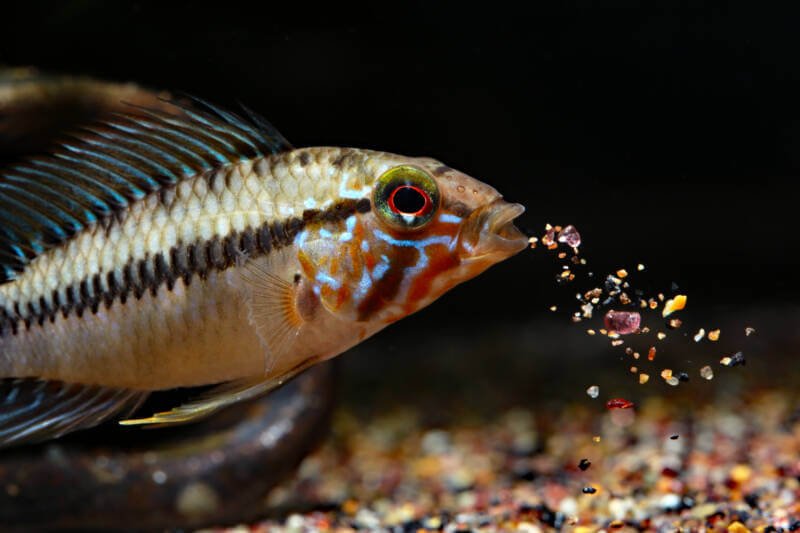
You have a rainbow to choose from, and you’ll find your new little acquisitions watching you and everything else going on in the room around them.
There are over 90 species in the Apistogramma genus, with new additions popping up the more scientists explore their native waterways.
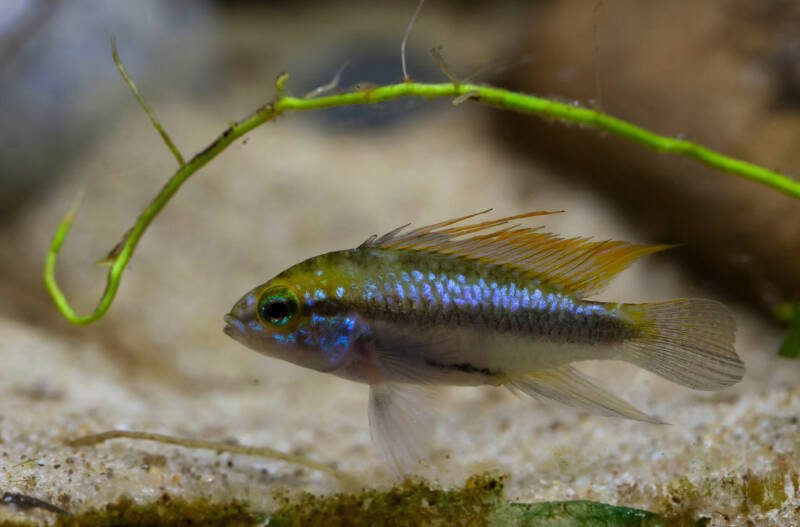
They may not rival the largest South American cichlids for aquarium room, but they have a semi-aggressive streak that keeps other fish on their fins.
While other colorful freshwater fish may remain content with their aquarium surroundings, apistos expand their interests to the world around them.
They engage with you and those who come into the room. It’s a curiosity that many find intriguing.
If you’ve considered adding apistos to your tank, make sure you have some experience under your belt.
Apistogrammas aren’t recommended for beginners from a management standpoint. They’re a little demanding – and not just when it comes to territory.
At a Glance
| Tank Size: | 20 gallons (90 l) |
| School Size: | Pairs or schools of at least four |
| Temperature: | 72-86°F (22.2-30°C) |
| Lifespan: | 5-10 years |
| Size: | 3.0-3.5 inches (7-9cm) |
| pH: | 6.0-7.0 |
| Hardness: | 2-15 dH |
| Ammonia: | 0 ppm |
| Nitrite: | 0 ppm |
| Nitrate: | <30 ppm |
In this article
In the Wild
Apistogrammas frequent slow-moving waters throughout the tropical region of South America.
This includes the eastern side of the Andes and throughout the Brazilian rainforests.
They gravitate to shallow, sandy-bottomed regions with dense plant cover.
Apistos have hardy reputations. They tolerate blackwater conditions. As plant material breaks down, the water grows dark from the decaying matter.
The Amazon, in particular, produces many pockets of blackwater along its length.
Unfortunately, many species are facing loss of habitat due to deforestation. The blackwater habitats they prefer are slowly disappearing.
Take the time to research your selected species before bringing your fish home, as you don’t want to contribute to dwindling numbers.
Size: a Range of Small
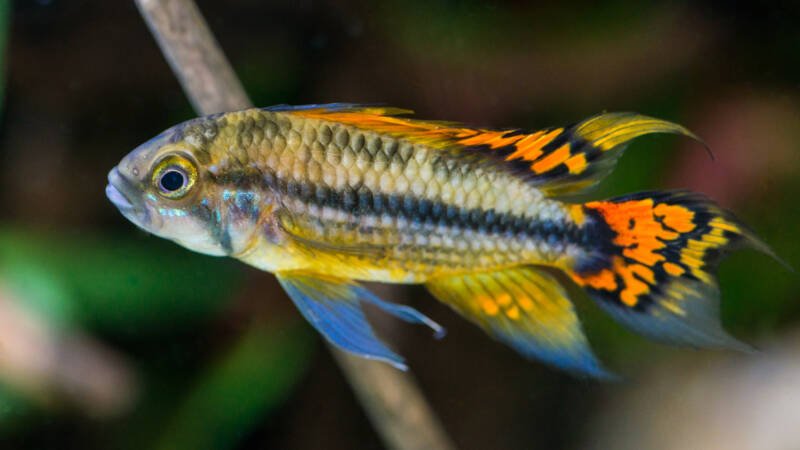
Apistos belong to the group of dwarf cichlids. As such, they don’t grow larger than an average size of 3 inches (7 cm).
However, there’s a range, depending on the species. Some drop into the nano aquarium range, getting little more than 0.8 inches (2 cm) long.
Male apistogrammas edge out the females. They’ll reach the most significant length (again, species-dependent) of 4 inches (10 cm).
Females come up shorter – only around 2 inches (5cm). It’s one of the defining characteristics between the two sexes.
Lifespan
Unlike ram cichlids, apistos have a better history with captive husbandry.
Their lifespan relates to their species, but you can expect to get an average anywhere from 5 to 10 years. Obviously, the better your management, the longer your fish will live.
Apistogrammas that end up subject to high-stress levels – whether from improper tank conditions, poor choice of tank mates, or unbalanced schools – won’t achieve the high end of that lifespan. Stress leads to illness and early death.
Behavior
Not quite reaching the bully level of the Jack Dempsey (another popular South American cichlid), apistogrammas have a semi-aggressive streak.
They set up and defend territory along the bottom of the tank, chasing away interlopers.

That aggression spikes during the spawning season (not much you can do then), or if food supplies start dwindling (you CAN control that!).
And if you opt to keep one apisto in the tank as a centerpiece, expect to find yourself with a bully on your hands.
Apistogrammas do better in mated pairs or as a harem. (Skip more than one male – you’re asking for trouble)
A school of one male and three females – or more – keeps problems to a minimum. You’ll see them settle down and live happily, even in a community tank.
Apistos have a curious streak that extends beyond the bounds of the aquarium’s walls. It’s one of their most endearing traits.
They pay attention to you and anyone else that approaches the tank.
You’ll find them swimming over to investigate and watching your every move.
Many aquarists love these fish for that interaction. Apistos often learn to recognize you and others in the household.
Expect them to start clamoring at the glass during feeding time…or whenever you happen to come near – in case you might have a snack.
Apistogramma Tank Setup
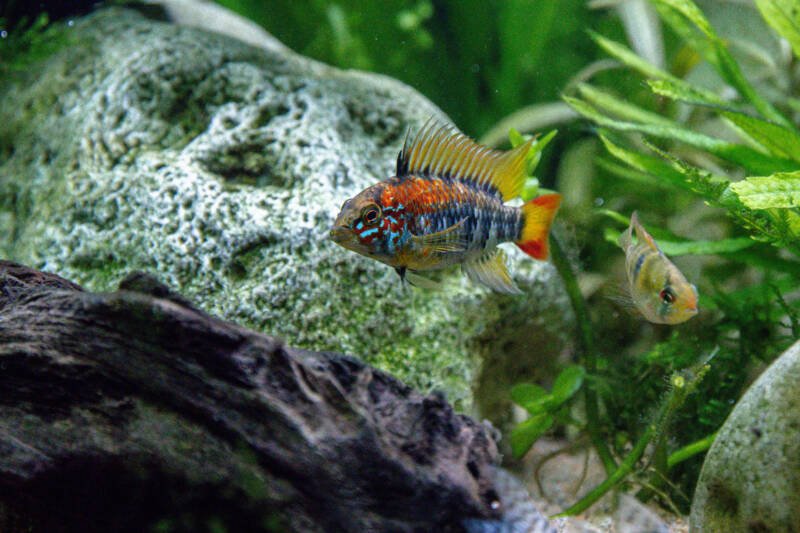
Due to these dwarf cichlids’ small size, you can get away with a 20-gallon (75 l) tank.
However, if you want to minimize aggression problems and keep everyone comfortable, consider upgrading to a 30-gallon (113 l) tank.
Many aquarists consider apistos nano fish, and they place them in smaller tanks.
You want to strike the perfect balance between providing enough territory for your fish to feel at home without adding TOO much space to overwhelm them. Look carefully at your school size.
And while apistos may come in tiny packages, the amount of waste they produce is far from small.
You want a hefty filter to handle clean-up. The Fluval FX4 does the trick nicely, without creating so much outflow your apistos struggle to swim around.
Water Conditions
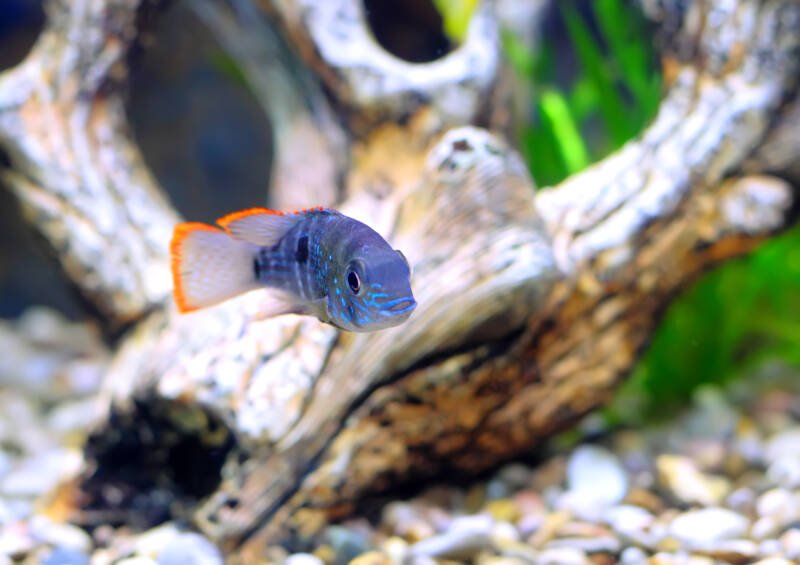
You want to make sure you research the needs of your particular species. However, all apistogrammas come from tropical regions.
They tolerate a temperature range between 72-86°F (22-30°C) but check for specifics.
Almost all of the species gravitate to blackwater regions in the wild.
The sandy bottoms collect leaf debris that breaks down, resulting in soft, slightly acidic waters. Most are also stained dark from the decaying plant matter.
You can usually get away with a pH value between 6.0-7.0, but do your research carefully. Your species may have different needs. It’s why you’ll also see water hardness levels ranging from 2-15 dH.
If need be, add Indian almond leaves or alder cones to the tank. As plant material starts breaking down, it’ll naturally soften the water for you.
It’ll also release tannins into the water. This creates a natural blackwater aquarium for you – mimicking their native environment.
Decorating the Apistogramma Tank
Cichlids and sand go together like plants and sunlight. Nothing makes apistogrammas happier than digging around in the substrate.
Choosing sand protects your dwarf cichlids from damage when they go about their burrowing.
Selecting sand as a substrate provides a second benefit – for you.
Instead of spending your free time sculpting the bottom back into shape every time your dwarf cichlids relandscape, sand settles to the bottom in natural patterns. The tank retains a natural pattern with little effort.

Avoid marketed cichlid sands, though. Such products contain aragonite, which is high in calcium carbonite.
The calcium leaches into the water, throwing off your pH and water hardness levels. You’re better off sticking to ordinary sand.
In the wild, apistos prefer regions with dense plantings. You want to strike the right balance between live plants that can handle some nibbling from your omnivores and hold up to their excavations.
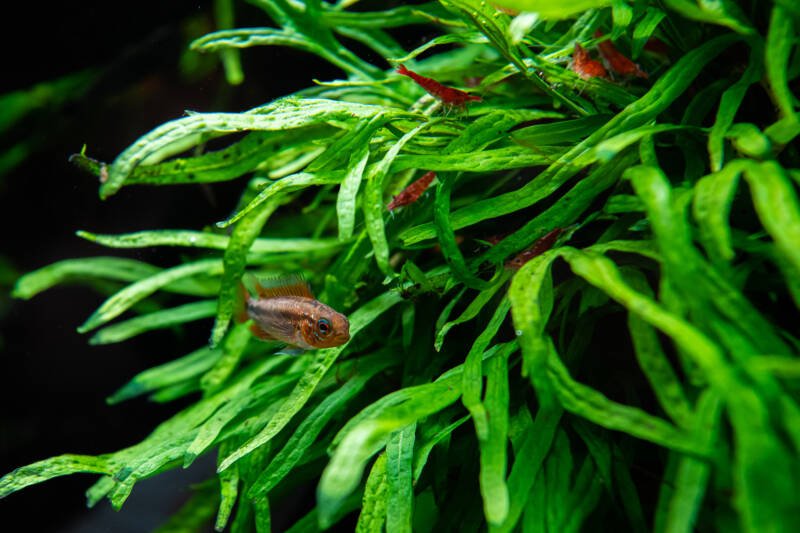
Some of the sturdiest options include:
- Ceratopteris thalictroides
- Cryptocoryne
- Flame moss
- Helanthium tenellum
- Java fern
- Java moss
- Water sprite.
If you lean toward mosses or Java fern, you won’t struggle to keep your plants anchored in the sandy substrate.

Mosses don’t need to root into the bottom to retain their hold. Your apistos get their plant cover without accidentally uprooting anything.
And while apistogrammas have that territorial streak, they also feel bashful from time to time.
Make sure you offer some caves or tubes, so they have somewhere to retreat to when they feel nervous.

Just don’t overcrowd the bottom, as that’s their preferred swimming area.
Apistogrammas in Communities
So long as you select an appropriate school and provide enough space for your apistogrammas to feel at home, they make perfect additions to community aquariums.
They stay along the bottom, leaving the middle and top of the water column free to populate with tank mates.
Tank Mates
You want to choose peaceful fish for the remainder of your tank.
Apistos do well as long as everyone sticks to their designated regions. You’ll avoid stress in the tank – for everyone.
Ideal tank mates include:
- Apistogramma species
- Bolivian ram
- Bristlenose plecostomus
- Cardinal tetras
- Corydoras
- Neon tetras
- Otocinclus
- Pencilfish
- Rasboras.
If you choose to add other bottom-dwelling fish to your tank, do so with caution.
Your apistos will immediately start squabbling over their territory. You may need to consider a larger tank in order to accommodate everyone comfortably.
Incompatible Species
While apistos have that semi-aggressive tendency, you want to avoid larger species. You’ll overwhelm your dwarf cichlids, prompting them to seek shelter. When confronted with a bigger fish, these bullies back down.
Any fish known to have a fin-nipping habit are also out.
Males often have prominent dorsal fins, and the spectacular fin rays present too much of a temptation. You don’t want to cause any problems with fin rot showing up in your tank.
Diet and Feeding
Apistogrammas fall into the omnivore category. However, they lean heavily on the meatier side of the menu.
You’ll want to strike the proper balance to keep those colors looking their best. You may want to consider investing in some quality homemade fish food recipes.
If you opt for a portion of commercial fish food, make sure you choose a nutritionally-dense sinking-style.
Apistos WON’T dart up to the surface to compete with other fish for food. They wait for everything to drop to the bottom, and you want those nutrients intact.
Apistos prefer live foods if given the option. You can trade out freeze-dried or frozen options if you want to save some pennies.
Just try to avoid making that a habit. Their favorites include:
- Brine shrimp
- Glass worms
- Larvae.
Don’t skip the greens part of the diet. They might nibble on the plants in the tank, though they prefer algae (if you have any available on the décor).
Peeling and dropping slices of cucumber will also provide a perfect apisto treat.
Breeding: A Variety of Strategies

Apistogrammas lay eggs, but then they have a few strategies for incubation. Some species mouth-brood, while others prepare and guard nests.
Take a look at the method used by your species, so you have an idea of what to expect.
In general, it’s not difficult to breed apistos in captivity. If you find yourself with a bonded pair, they may take care of things on their own.
However, the resulting aggression spawning season will place on a community tank could cause spiked stress levels.
You don’t want to end up with a risk of dropped immunity for ANY of your fish.
As such, consider taking the time to set up a separate breeding tank if you want to breed your apistos. All of your fish will thank you.
Males or Females?
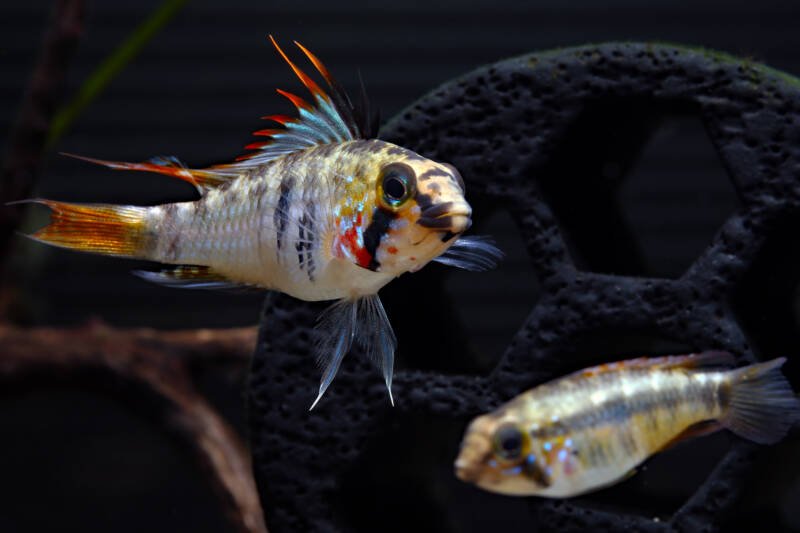
As already noted, apistos show sexual dimorphism. Males come in at a larger size. They also have brighter color patterns.
However, during the spawning season, females brighten up their colors. So your best bet is to look at the difference in size.
Depending on your species, your male apisto will also have a larger, more prominent dorsal fin.
The size difference is a more reliable indicator of male versus female, particularly if you have a bonded pair preparing to spawn.
Parental Responsibility

Due to the aggressive spike seen during the spawning season, your best bet for success is to prepare that separate breeding tank for your apistos.
It’ll lower the stress level for EVERYONE. A 10-gallon (38 l) tank will do the trick for your bonded pair – just don’t leave them there.
Make sure you set up your breeding tank as you would your community tank.
You want your pair to feel comfortable. Using a timer on your aquarium lights will help simulate a regular day-night schedule.
Cover the filter’s intake valve with a sponge. This will protect the fry from getting sucked into the mechanism. It also creates a feeling of “water stagnation” for the parents.
Incrementally, by 1-2 degrees each day, increase the tank’s temperature to 80°F (26.6°C).
You want to provide several cave options for your female to choose from. When she’s ready, she coaxes the male into the cave.
She lays around 80 eggs for him to fertilize. Both of them then guard the cave from intruders (which should be easy, as no one else should be in the tank).
After 2-5 days, the eggs hatch. The mother feeds the fry by showing them where the food’s located.
You can help by adding baby brine shrimp to the tank to aid in fry growth. They will reach full maturity at around 4-months-old.
Health & Disease
Overall, apistogrammas don’t have any unusual health issues.
So long as you stay on top of their water conditions, avoid stressful situations, and provide high-quality food, they shouldn’t have any problems.
Most aquarists that see issues with their apistos also struggle with water quality.
As stress levels rise, apistos lose their immunity, and you could find yourself battling:
- Ich
- Parasites
- Skin flukes.
Apistogrammas: Are They for You?
With their vibrant colors and unique personalities, apistos have achieved popularity with aquarists.
The most common color varieties run a moderate cost of $12 per fish. If you want a more dramatic pattern, you could spend several hundred dollars – especially if wild-caught.
The dramatic variation of the species available ensures a dwarf cichlid for every aquarist’s taste. These little fish differ in palette, fin formation, and even personality.
You can find an apisto to suit the aquarium you’re looking to build without a problem.
Popular Apistogrammas
1. Agassiz’s Dwarf Cichlid (Apistogramma agassizii)

Agassiz’s dwarf cichlids come in a variety of different colors. The gold variety ranks at the top with most aquarists, with a blue type close behind.
They differ from cockatoos with their black patterns and sleeker shape.
While on the smaller side – even for a dwarf cichlid – Agassiz’s dwarf cichlids have a reputation for being more territorial than other apistos. (Napoleon complex much?)
So while you may think you can get away with a smaller tank, you’ll actually need more space to keep them happy.
2. Dwarf Cockatoo Cichlid (Apistogramma cacatuoides)
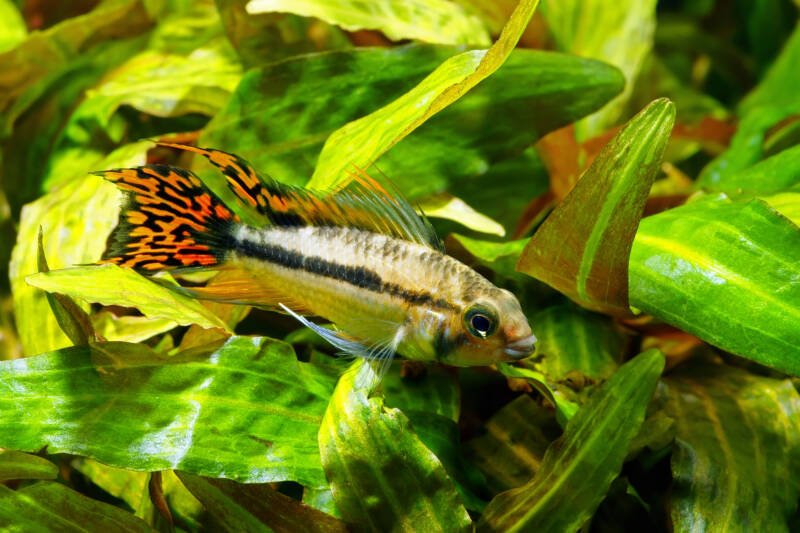
Apistogramma cacatuoides, or the dwarf cockatoo cichlids, top the list in popularity.
Male cockatoos have dramatic dorsal fins nearly as tall in height as the fish are long, mimicking the spray of feathers found on the bird for which they received their name.
Cockatoos all sport a stripe along their lateral line, though the color variations spread through the rainbow.
The remainder of their fins has a light, feather quality, making them a tempting target for fin-nippers. You’ll want to choose their tank mates carefully.
3. Umbrella Cichlid (Apistogramma borellii)

Umbrella cichlids have scales that shade through delicate yellows and blues.
The primary yellow scales have also earned them the common name yellow dwarf cichlid, though it’s hard to overlook the beautiful blue tones on their fins.
Many individuals sport iridescent blue or red spots along their heads, giving them a unique appearance.
Umbrellas have a reputation as one of the gentlest members of the dwarf cichlid group, making them a perfect addition to community tanks.
Dwarf Cichlids
Apistogrammas charm aquarists with their vibrant color palettes and inquisitive personalities.
And while you need to take care with their husbandry – not to mention that semi-aggressive streak – they make wonderful additions to community aquariums.
Which species of apisto do you have? How do you manage their aggression?
What breeding style have you observed?
Share your questions and stories with us here!